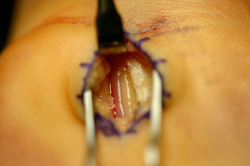Neuroma

A neuroma is a thickening or swelling of the nerve. The most common place for this to occur in the feet is between the third and fourth toes. This is commonly called a Morton's neuroma or intermetatarsal neuroma. This thickening or enlargement of the nerve can cause pain and irritation. Symptoms would include tingling, burning, pain, numbness, and a feeling of walking on the leather, bunched up sock, or marble.
Anything that causes irritation or inflammation to the nerve can be considered a cause of the neuroma.
Common causes of neuroma would include tight fitting shoegear, equinus or tight calf musculature, bunions, hammertoes, metatarsus adductus, wide feet/splayfoot, abnormal forefoot or rearfoot motion.
A foot and ankle surgeon through adequate history and physical will be able to determine the cause of your neuroma. X-rays may be considered in order to rule out causes of neuroma such as traumatic or biomechanical factors. Ultrasounds are occasionally used as well in the diagnosis of soft tissue pathology. If the cause of irritation is not removed symptoms will likely worsen and the neuroma will likely increase in size with possible permanent nerve damage. It is always best to see your Doctor as soon as possible to prevent long-term complications, and potentially avoid surgery.
If it is determined that you do have an neuroma a nonsurgical treatment would include: rest, ice, elevation , anti-inflammatory medications such as nonsteroidal anti-inflammatory's, activity modifications, accommodative or custom orthotic devices, padding, injection therapy , and physical therapy modalities.
Surgical therapy is usually only considered after a patient has been deemed nonresponsive to conservative therapy. Surgical therapy usually includes two categories:
1-Decompression of nerve and scar tissue.
2-Removal of inflamed neural tissue/neuroma.
It is important to note that regardless of the treatment for a neuroma the underlying cause ie. biomechanical deformity/trauma or cause is also addressed. This is why it is important to see somebody that has been specifically trained in biomechanics of the foot and ankle.
Anything that causes irritation or inflammation to the nerve can be considered a cause of the neuroma.
Common causes of neuroma would include tight fitting shoegear, equinus or tight calf musculature, bunions, hammertoes, metatarsus adductus, wide feet/splayfoot, abnormal forefoot or rearfoot motion.
A foot and ankle surgeon through adequate history and physical will be able to determine the cause of your neuroma. X-rays may be considered in order to rule out causes of neuroma such as traumatic or biomechanical factors. Ultrasounds are occasionally used as well in the diagnosis of soft tissue pathology. If the cause of irritation is not removed symptoms will likely worsen and the neuroma will likely increase in size with possible permanent nerve damage. It is always best to see your Doctor as soon as possible to prevent long-term complications, and potentially avoid surgery.
If it is determined that you do have an neuroma a nonsurgical treatment would include: rest, ice, elevation , anti-inflammatory medications such as nonsteroidal anti-inflammatory's, activity modifications, accommodative or custom orthotic devices, padding, injection therapy , and physical therapy modalities.
Surgical therapy is usually only considered after a patient has been deemed nonresponsive to conservative therapy. Surgical therapy usually includes two categories:
1-Decompression of nerve and scar tissue.
2-Removal of inflamed neural tissue/neuroma.
It is important to note that regardless of the treatment for a neuroma the underlying cause ie. biomechanical deformity/trauma or cause is also addressed. This is why it is important to see somebody that has been specifically trained in biomechanics of the foot and ankle.